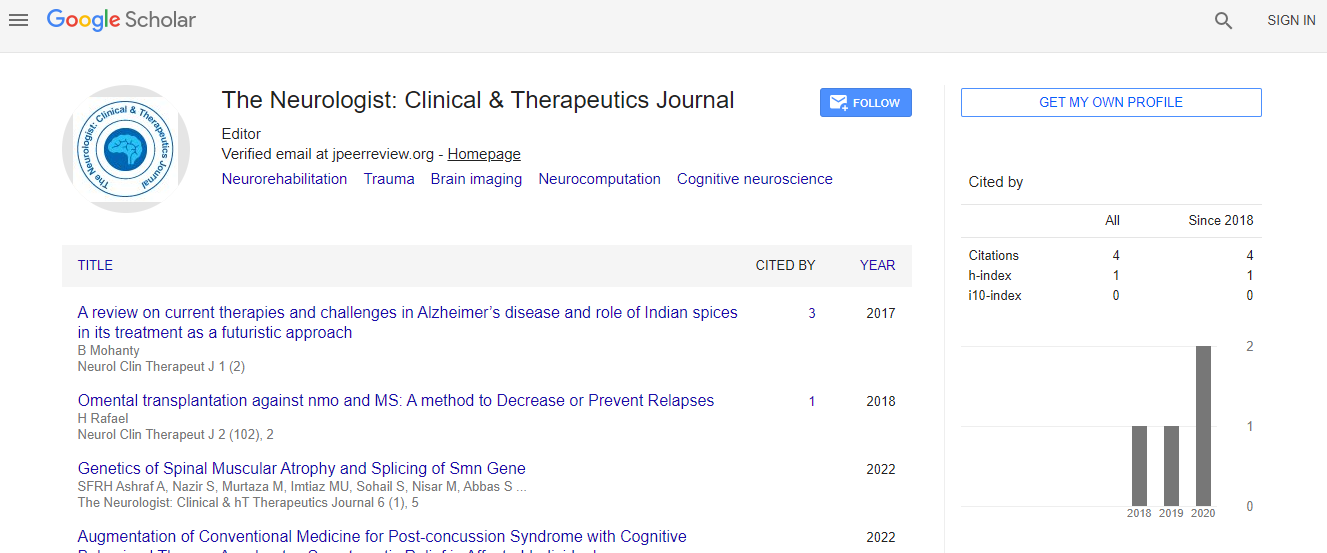Neurology Congress 2018: Fluorodeoxyglucose-18-PET/CT in preoperative epilepsy - our experience - Tomas Budrys - Lithuanian University of Health Sciences Clinical Hospital
*Corresponding Author:
Copyright: © 2018 . This is an open-access article distributed under the terms of the Creative Commons Attribution License, which permits unrestricted use, distribution, and reproduction in any medium, provided the original author and source are credited.
Abstract
Successful surgical ablation upon exact restriction of the epileptogenic cortex. This is significant both to guarantee a total resection of the epileptogenic center and to diminish the resection volume however much as could reasonably be expected, restricting any possible neurocognitive deficiencies. To this end, patients regularly experience a serious and broad preoperative assessment in mix with anatomical and useful imaging. We looked at the measure of epileptogenic foci, decide most normal limitations of epilepsy central focuses in both practical and basic imaging strategies and decided the achievement pace of medical procedure in the worked patients when the central purposes of epilepsy harmonized in each of the three imaging techniques. A recent randomized controlled trial confirmed the longstanding observation that surgery is superior to prolonged medical therapy in refractory temporal lobe epilepsy (TLE). The precondition for a successful operation is the careful, precise identification of the operationally defined epileptogenic zone (EZ), removal of which is expected to lead to seizure freedom in a majority of patients. A previous meta-analysis has described several predictive factors for surgical outcome. Nonetheless, the decision algorithm for epilepsy surgery is generally based on empirical and center-specific logistics.
Methods:
An extensive computer literature search using “Medline” and “PubMed” was performed. Key words were “Epilepsy surgery”, “Epilepsy surgery positron emission tomography”, “Epilepsy surgery PET”, “Epilepsy surgery outcome”. Each content list of the journals identified by the publications was used for a hand search. Fourteen patients underwent neurosurgical operation with removal of epileptogenic foci. Assessment of normality was verified by the Kolmogorov-Smirnov and Shapiro-Wilk tests. The Wilcoxon Signal Criteria were used to compare the two dependent samples whose data did not match the normal distribution. Concordance was evaluated by using Cohen's kappa. A meta-analysis of publications from 1992 to 2006 was performed. Forty-six studies were identified that met inclusion criteria presenting detailed diagnostic test results and a classified postoperative outcome. Studies exclusively reporting on patients with brain tumors or on children were excluded.
Results:
Ten out of fourteen patients experienced medical procedure and exhibited superb postsurgical results, with no epileptic seizures one year or progressively after the activity; 3/14 patients had 1-2 seizures after medical procedure and one patient had same or increasingly epileptic seizures in span of one year or more. Most regular confinement for epileptogenic movement in every one of the three techniques was worldly flap (39.6-48.6%). The examinations were confused by critical contrasts in study plan and frequently by absence of exact patient information. Ipsilateral PET hypometabolism indicated a prescient estimation of 86% for good result. The prescient worth was 80% in patients with typical MRI and 72% in patients with non-confined ictal scalp EEG. In a chose populace of 153 TLE patients with a follow-up of >12 months PET related well with other non-intrusive demonstrative tests, yet none of the chances proportions of any test mix was significant.
Conclusion:
Surgical treatment may offer patients with intractable epileptic seizures. PET/CT are amazingly helpful imaging technique to aid the restriction of epileptogenic zones. The dynamic useful data that mind PET/CT give is exceptionally integral to anatomical imaging in MRI and useful data in EEG. Ongoing Publications 1. Fisher R S, Acevedo C, Arzimanoglou A, Bogacz A, Cross J H, Elger C E, et al. (2014) ILAE official report: A commonsense clinical meaning of epilepsy. Epilepsia. 2. Murray C J, Vos T, Lozano R, Naghavi M, Flaxman A D, Michaud C, et al. (2010) Disability-balanced life years (DALYs) for 291 maladies and wounds in 21 districts, 1990-2010: A methodical investigation for the Global Burden of Disease Study 2010. Lancet 380(9859). 3. Maganti R K and Rutecki P (2013) EEG and epilepsy observing. Continuum (Minneap Minn). 4. Roy T and Pandit A (2011) Neuroimaging in epilepsy. Archives of Indian Academy of Neurology 14(2):78-80. 5. Cendes F (2013) Neuroimaging in examination of patients with epilepsy. Continuum (Minneap Minn). Our information affirm that ipsilateral PET hypometabolism might be a pointer for good postoperative result in presurgical assessment of medication safe TLE, in spite of the fact that the genuine symptomatic included worth stayed faulty and hazy. PET doesn't seem to include an incentive in patients restricted by ictal scalp EEG and MRI. Planned examinations restricted to non-limited ictal scalp EEG or MRI-negative patients are required for approval.

 Spanish
Spanish  Chinese
Chinese  Russian
Russian  German
German  French
French  Japanese
Japanese  Portuguese
Portuguese  Hindi
Hindi 